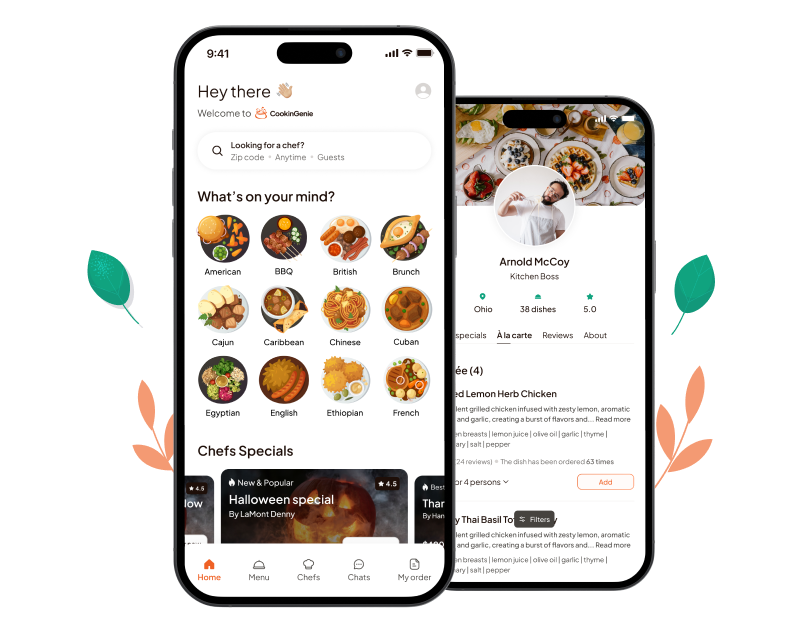Know what’s in your food: Making sense of food labels
We’ve all been there- we’re standing in the grocery store aisle, staring at an extensive list of ingredients on a food label, and have no idea what over half of them are. Most people don’t even bother reading the labels on the foods they buy; they assume that if a store is selling them, they must be safe to eat. However, there are a lot of harmful ingredients that are hiding in plain sight in our food supply.
This post will deeply dive into everything you need to know about food labels, including what to look for and how to interpret the information. We’ll also provide tips on making healthier choices for you and your family. With this knowledge, you’ll be able to make informed decisions about the food you eat and feel confident that you’re doing everything possible to keep your family safe and healthy.
What is a Food Label?
A food label is on the packaging of all food items in the United States. The label provides essential information about the food, including the serving size, calories, fat content, and other nutritional facts. The label also lists any allergens that are present in the food. The Food and Drug Administration (FDA) regulates food labels, and companies that do not comply with the labeling requirements can be subject to fines. Food labels help make informed choices about the foods you eat. For example, if you are trying to lose weight, you may look for foods with low-calorie counts, while if you have diabetes, you may focus on foods with low sugar content. You can choose foods that fit your needs by reading food labels carefully.
Understanding the Different Sections of a Food Label
A food label is more than just the name of the product. The food label can provide a wealth of information about a food’s nutritional value and any potential allergens it may contain.
Here is a breakdown of the different sections of a food label:
A. Ingredients List
The ingredients list on a food label is vital information for you. It can help you understand what is in the product and how it got made. The ingredients list is in descending order by weight. This order means that the ingredient that weighs the most is listed first, and the ingredient that weighs the least is listed last. The ingredients list is straightforward to read. The allergens list is usually in bold type at the end of the ingredients index. The ingredients list can help you make informed choices about your food. It can also help you avoid potential allergens. When reading the ingredients list, always look for recognizable ingredients and check anything you need help understanding.
When you look at the label on a food product, you might be surprised to see just how many ingredients are listed. For example, a typical can of soup might contain water, tomatoes, carrots, celery, onion, wheat flour, vegetable oil, salt, and various spices. While some of these ingredients are essential for the soup’s flavor and texture, others are for purely practical purposes. For example, wheat flour thickens the soup, while vegetable oil prevents the different ingredients from sticking together. Even though it may seem like a lot of elements in your favorite soup, most are there for a reason.
B. Nutrition Facts Panel
Food labels list the nutritional content of each food product. The United States Food and Drug Administration (FDA) requires that all packaged foods have a nutrition label. The label must be easy to read and commonly include the following information: the serving size, the calories per serving, the amount of fat, cholesterol, sodium, carbohydrates, dietary fiber, sugars, protein, vitamins, and minerals. The FDA also requires that food labels list the daily value percentage for each nutrient. The daily value is per 2,000-calorie diet.
It is important to note that the serving size listed on the label is not necessarily equivalent to the recommended serving size for a given food. For example, a soda can have one serving size, but the recommended serving size for soda is much smaller. As such, paying attention to the serving size and the number of servings per container when reading nutrition labels is essential.
1. Serving Size: The serving size is the amount of food in one serving and appears in both metric and customary units. The number of servings per container is also on the label. The serving size usually differs from the portion size, which is the amount of food you eat. For example, a can of soup may have two servings, but you may eat the whole can, which would be four. The number of calories and other nutrients are listed next to the serving size. The FDA requires that all packaged foods have a nutrition facts label that includes the serving size, the number of servings per container, the calories, and other nutrients. The FDA has also established Reference Daily Intakes (RDI) for vitamins and minerals. The RDI is the average daily intake sufficient for 97-98% of the population.
2. Total Calories: The total calories on a food label provides the consumer with valuable information about the product’s nutritional content. This number indicates how many calories are in one serving of the food, and it can help determine if the product is a desirable choice for a healthy diet. The total calories can also help compare various products and make informed decisions about purchasing foods.
Foods high in calories are also high in fat and sugar, while low-calorie foods are usually lower in these nutrients. For this reason, it is crucial to consider the other nutritional information on the food label when deciding which products to buy.
3. Total Fat: The “Total Fat” on a food label includes all forms of fat: saturated, unsaturated, and trans fats. These values are essential to know because diverse types of fat have various effects on our bodies.
- Saturated fats are solid at room temperature and are present in animal products such as butter, cheese, and meat.
- Unsaturated fats are liquid at room temperature and are present in plant-based oils such as olive oil and canola oil.
- Trans fats occur when manufacturers add hydrogen to liquid oils to make them solid, and they are often present in processed foods such as cookies, crackers, and cakes.
Out of these fats, trans fats are the most harmful type of fat because they raise LDL (bad) cholesterol levels and lower HDL (good) cholesterol levels, which can lead to heart disease. So when looking at the “Total Fat” on a food label, be aware that it may include all types of fat – some of which are more harmful than others.
4. Cholesterol: The cholesterol value on the nutritional fact section of the food label refers to the amount of cholesterol in milligrams (mg) present in each serving of the food. Cholesterol is a type of fat in animal-based foods and is necessary for the proper function of cell membranes and the production of certain hormones. However, too much cholesterol can lead to a build-up in the arteries, increasing the risk of heart disease.
The American Heart Association recommends consuming no more than 300 mg (about the weight of ten grains of rice) of cholesterol daily. When choosing foods, it is vital to check the nutritional label to see how much cholesterol is present in each serving. Foods high in cholesterol include eggs, butter, and fatty meats. However, many low-cholesterol options, such as fish, skinless chicken, and tofu, are also available. By making smart choices, you can help keep your cholesterol levels under control and reduce your risk for heart disease.
5. Total Carbohydrates: The Total Carbohydrates value on the nutritional fact section of the food label indicates the total amount of carbohydrates in a product. This value includes simple and complex carbohydrates and sugar added to the product. The entire carbohydrate content of a food can be a helpful guide for those trying to control their blood sugar levels or manage their weight.
Foods high in carbohydrates should be consumed in moderation, while you can have those lower in carbs more freely. However, it is essential to remember that not all carbs are created equal. Some carbs, such as those found in whole grains, are very healthful. So, when looking at the Total Carbohydrates value on a food label, consider the other information on the label, such as the fiber content and the glycemic index. This information will give you a complete picture of the product’s healthfulness.
6. Protein: Proteins are essential macronutrients that perform a variety of functions in the body, including helping to build and repair tissues, producing enzymes and hormones, and boosting the immune system. As a result, proteins play a vital role in keeping the body healthy and functioning correctly. The nutritional value of proteins is present on the “nutritional facts” label of most food products. This label provides information on the amount of protein per serving and the percentage of the daily value (DV) that this protein represents.
The DV for protein is per 2,000-calorie diet, so it is important to remember that this number will vary depending on your individual calorie needs. However, the general rule is that if you are an adult, you should consume 10-35% of your daily calories from protein. As such, the nutritional value of proteins is crucial to consider when deciding on your diet.
7. Minerals, Vitamins, and Other Nutrients: Most people are familiar with the nutritional facts labeled on food packaging, but many need to learn how to interpret the information it provides. The label includes various nutrients, including minerals, vitamins, and other nutrients. Each of these has a different value regarding the body’s daily needs. For example, minerals are essential for bone health, and vitamins are necessary for metabolism. Other nutrients, such as fiber, can also be beneficial.
However, it’s important to remember that the values listed on the label are per 2,000-calorie diet. These values indicate that if you consume over 2,000 calories (about 2 and a half hours of running) per day, you may need to adjust your intake of these nutrients accordingly. Understanding the nutritional facts label ensures you get the right balance of nutrients for your needs.
C. Allergen Labeling and Omissions
The FDA regulates allergen labeling for packaged foods sold in the United States. The top eight allergens must be listed on the label if they are present in the food. The eight allergens are milk, eggs, fish, crustacean shellfish, tree nuts, peanuts, wheat, and soybeans. If packaged food contains any of these allergens, it must say so on the label. For example, if a cereal includes wheat, the label must say “Contains wheat” somewhere on the package. There are two situations when manufacturers avoid allergen information from the label:
- If packaged food is made in a facility that processes one of the major allergens. For example, if a cracker is from a facility that processes wheat, the cracker label would not have to list wheat as an ingredient.
- If the packaged food is considered “Generally Recognized As Safe” (GRAS). Some examples of GRAS foods are coffee beans and spices. These foods do not have to list any ingredients on their labels, including allergens.
Despite these exemptions, many manufacturers still voluntarily include allergen information on their labels even when they are not required. When reading food labels, always check for allergen information in the ingredient list and any voluntary allergen statements that may be present. If you have any questions or concerns about allergens in packaged foods, consult with an allergist or your physician.
Tips for Making Sense of Food Labels
Do you get confused by food labels? You’re not alone. The FDA regulates what information to include on food labels, but there’s a lot of information to sort through, and it can be tough to know what it all means. Here are some quick tips for making sense of food labels:
- Start with the basics: The label must include the product’s name, the list of ingredients, the net quantity of contents, the name and address of the manufacturer, and any mandatory allergens.
- Know your nutrients: The label must also list the percentage of certain vital nutrients, including fat, saturated fat, cholesterol, sodium, carbohydrates, dietary fiber, sugars, and protein.
- Check the calories: The label must include the number of calories per serving. This value can be helpful if you’re watching your weight or trying to maintain a healthy diet.
- Pay attention to serving sizes: The label lists the number of servings per container. This value is essential because the calorie and nutrient information is for a single serving. Be sure to check the serving size before you compare it to your portion size.
- Get a handle on % daily value (%DV): This information tells you the percentage of each nutrient in one serving in terms of how much it contributes to your daily recommended intake. For example, if a food has 5% DV for fat, one serving has 5% of the total fat you should consume daily.
- Look for “Low,” “Reduced,” and “Light.”: These terms indicate that a food has significantly less of a specific nutrient than its regular counterpart – which can be helpful if you’re trying to cut down on certain nutrients like fat or sodium. However, remember that “low-fat” does not necessarily mean “low-calorie.”
- Avoid foods with claims like “all-natural” or “no additives”: The FDA does not regulate these claims and, therefore, may not mean what you think they mean. For example, “all-natural” doesn’t necessarily mean that a food has no artificial ingredients – it could just mean that it includes ingredients that occur naturally in nature. Likewise, “no additives” doesn’t necessarily mean that food doesn’t contain preservatives – it could just mean that no new additives have been added during processing.
- Be wary of health claims like “fat-free” or “heart-healthy”: These claims are often misused and can be misleading. For example, just because a food reads “fat-free” doesn’t mean it’s calorie-free or automatically suitable for you – it could still be high in sugar or other unhealthy ingredients. And while “heart healthy” sounds good, remember that this claim can only be for foods that meet specific criteria set by the FDA – so not all foods advertised as “heart healthy” are good for your heart health. When in doubt, always check with your doctor or Registered Dietitian before making any significant changes to your diet based on health claims on food labels.
- Focus on ingredient quality rather than quantity: Just because an ingredient is listed first doesn’t mean it’s present in higher amounts than other ingredients – they’re simply in order of descending predominance by weight. So instead of focusing on the order of ingredients, focus on their quality. For example, choose foods with whole grains as the first ingredient rather than refined grains.
Conclusion
To summarize, food labels can be beneficial when making healthy choices. By looking at the calories, fat, sodium, and other nutrients listed on a food label, you can better understand what you’re putting into your body. However, it’s important to remember that food labels are not always 100% accurate, so it’s still essential to use other sources of information when making decisions about your diet. However, food labels are a valuable tool for you to eat a healthy diet.



 Settings
Settings
 Gift Card
Gift Card Blog
Blog Locate Us
Locate Us










 Home
Home
 Chefs
Chefs
 Chats
Chats
 My Order
My Order



